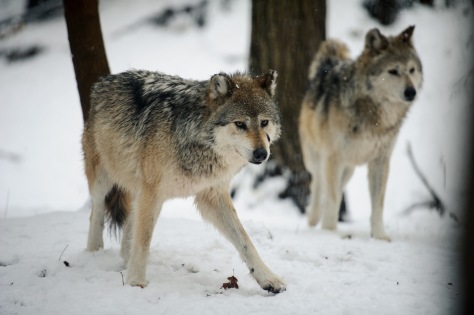For the second year in a row, Lake Superior froze around Isle Royale National Park in Houghton, Michigan. This allowed wolves and other land animals to leave the island. But it could also have caused deaths within the dwindling wolf population.
After this winter, the Isle Royale wolf numbers were down to just three, as shown by the results of the 57th annual winter survey by Michigan Technological University, the longest-running predator-prey study in the world.
Six of the nine remaining wolves disappeared, but whether it was because they walked across the iced-over lake or simply died is still in question. Researchers know that one radio-collared wolf died, but the other missing five were not tagged and thus there is no way of knowing exactly what happened.

Image credit: Eric Kilby / CC BY-SA 2.0
The identity of the three remaining wolves can’t be verified until genetic testing is completed this year, but are suspected to be a male and female of 4 to 5 years old – close to the end of the average wolf life span in the wild – and a pup around 9 months old that is showing signs of genetic defects. Scientists believe that these last three wolves may not make it to next winter and that the deformed wolf may already be dead.
The deformities of the pup are a result of inbreeding, and a clear indication that the wolves are in desperate need of a “genetic rescue.” The wolves numbers have dropped since 2009 by 88%, from 24 to these three, which was probably due to such inbreeding.
Even if this pup were healthy, however, it would not necessarily be promising. With just three wolves, it is unlikely there would be a natural recovery within the population. A “genetic rescue” would entail transporting new wolves onto the island for breeding, which could naturally correct genetic problems like spine deformities and others issues.
But Michigan Technological University ecologists and co-leaders of the study John Vucetich and Rolf Peterson – who has worked on the study for more than 40 years – say it’s too late. Over the past six years, they have made a case for human intervention to no avail and now there’s little to no hope. Down to just three, the wolf numbers are too low and the older pair would not be very interested in mating with newly introduced wolves.
The only real chance for these wolves’ survival is if new members of the species come over to Isle Royale. Isle Royale initially got its wolves in 1949, when Lake Superior froze over and a pair came into the park. Through those two original wolves, the population increased, averaging 23 over the years with as many as 50 in the 1980s and 30 in 1995.
When the lake froze in 2013-2014, there was hope that some wolves might wander over from Canada, Michigan or Minnesota but instead one wolf left and was later killed. This winter, a new pair did enter the island but left again shortly and, unfortunately, did not intermingle with the resident wolves.

Image credit: Ray Dumas / CC BY-SA 2.0
In the meantime, the moose population is growing at 22% a year, causing another worry for the area. The last four years has seen such light wolf predation that moose now have 1,250 of its species. Within five or so years, they will grow faster than their habitat can sustain and their numbers will then drop drastically.
But once there is available food again, the moose population may not bounce back as expected, due to the species stripping the land of its ability to produce food. This is why Isle Royale needs wolves to naturally hunt them and keep the habitat-to-population ratios in balance. Vucetich and Peterson write in the annual report:
“Concerns remain that the upcoming increase in moose abundance will result in long-term damage to the health of Isle Royale’s vegetative community.”
So far, there are no intentions for humans to introduce new wolves to the national park. Isle Royale is making a new management plan, which could recommend such introduction, but it will be years before the plan is adopted.
Featured image: Gary Kramer, Wisconsin Department of Natural Resources / CC BY-ND 2.0

